construction union technology shift drawings 2d 3d
3D Printing: The Future of Construction
Published on Jan 31, 2022 by Jamie D.

In 2004, Professor Behrokh Khoshnevis of the Academy of South Carolina attempted the first 3D printed wall. Since and then, this innovation has exploded and it's now possible to build a firm in just 20 hours! The professor developed an FDM 3D printer, mounted on a robotic arm, that extrudes physical layers instead of plastic to create a 3D model.
This Contour Crafting engineering science demonstrated all the qualities needed to utilise additive manufacturing on construction sites: reduction in costs and waste product, faster construction speed, reduction of accidents, complex architectural shapes, and more. His discovery marked the beginning of 3D press in structure. However, information technology remains much less used than certain sectors such as aeronautics or medical.
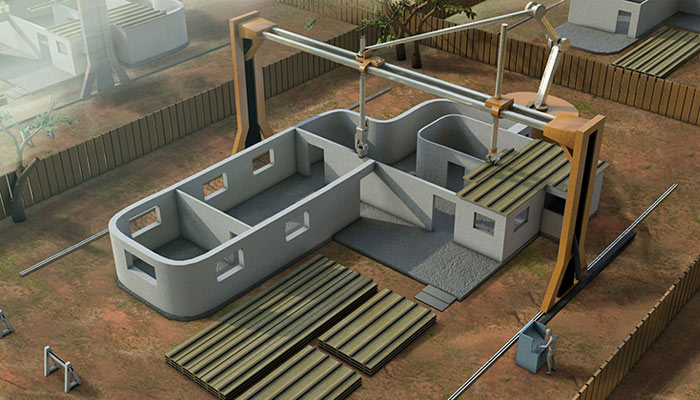
Large scale, industrial concrete printers tin create whole house structures apart.
Structure giants are quickly realising the potential of of 3D technologies and their touch on the future of construction. The concrete 3D printing market is expected to reach $56.4m in 2021, and with good reason. More and more companies are starting up in the sector to create new, innovative projects. Some are more futuristic, some are very real in the present, such as Apis Cor'south 3D printed house in 24 hours. 3D concrete printing is developing quickly and relies on different technologies and materials, offer many benefits to its users. The tech is withal in its infancy yet and is leap by current limitations.
What 3D printing processes in the construction sector?
1 – Robotic Arm Extruders
The Contour Crafting method involves the edifice material being deposited to create a large-scale 3D model with a smooth surface end. Track are installed around the building ground that volition act equally a construction to direct the robotic arm. Information technology moves dorsum and forth to extrude the physical, layer-by-layer. Trowels placed on the side and above the nozzle to flatten the extruded layers and ensure the model'due south strength.
In this procedure, conventional physical cannot exist used every bit it would need to harden before you could continue the process. If information technology was 3D printed information technology therefore wouldn't be able to support its ain weight. Therefore, concrete is used with quick setting properties.
Profile Crafting (visitor with the same proper noun as the method) are very discreet about their progress. Chinese structure company WinSun Ornamentation Engineering science Co describes it as able to "steal the show" notwithstanding. These machines are huge (32m long, 10m wide and 6.6m tall). This enables them to 3D impress full structures and get together them on the spot. This is done through mixing concrete and drinking glass fibres on-site and and so printing. This feat fabricated made builders and construction workers aware of additive manufacturing.
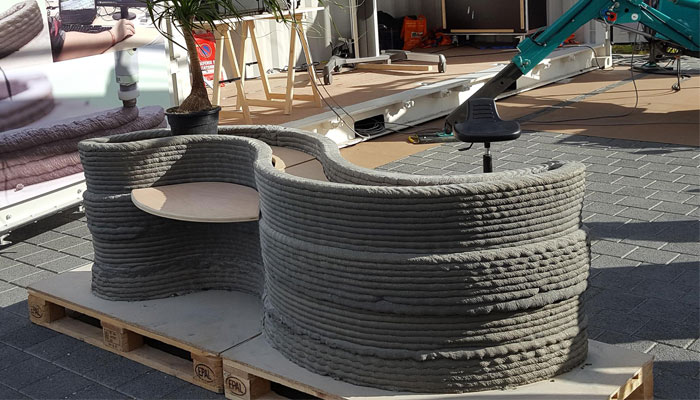
Constructions-3D are a competing company who are also trying to 3D print large concrete buildings using this tech.
Competing Companies
The different market players take developed machines using a diverseness of different technologies to 3D impress concrete. French visitor Constructions-3D have created a polar 3D printer which prints whilst inside the structure site, and then leave through the front door of the building once construction is finished. It consists of a mechanical base, and robotic arm with a nozzle for extruding the fabric at the end. This arm offers a printable area of more than 250 grand² and over eight metres high.
Cazza Construction'south robot is like to this, involving a mobile crane system allowing them to 3D print a far wider area and create larger and taller structures. This is shown in past prints from companies similar Apis Cor and XtreeE, quickly creating whole houses.
Other companies have specialised in extruding materials other than physical with this technology. BatiPrint 3D's patented process is a hit instance: the University of Nantes, Bouygues Structure and Lafarge Holcim joined forces to develop an industrial robot that prints iii layers of material at in one case. Ii of these layers are a polymeric cream, with the third layer beingness physical.Benoit Furet, professor at the University of Nantes explains "the foam brings inner and outer insulation; concrete and reinforcement the antiseismic bearing structure. "
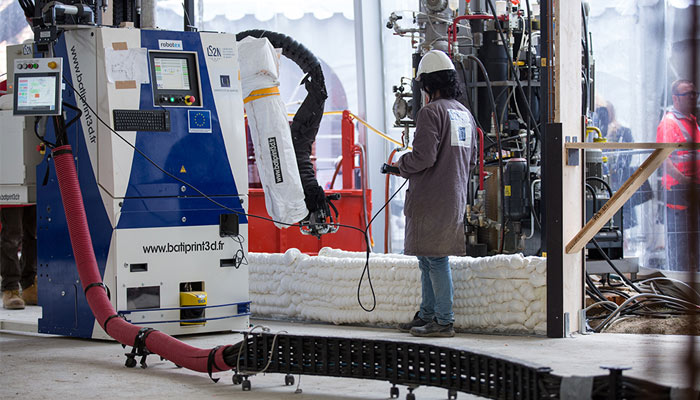
Batiprint 3D are a French company aiming to 3D print large structures.
2 – Sand layers linked together
Italian architect Enrico Dini first fabricated waves as 'the human who 3D prints houses.' More recently, he demonstrated an interesting 3D press process using his 'D-Shape' 3D printer. This automobile relies on the bounden of powder which makes it possible to solidify a layer of material with a binder. Layers of sand are deposited according to the desired thickness before a impress head pours droplets (the binder) to harden the sand. This 4 x 4 metre machine tin can create large structures of up to half dozen cubic metres in size.
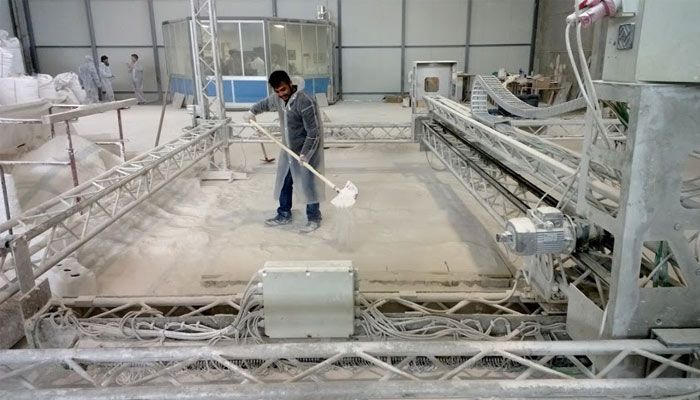
The print site where the D-Shape will 3D print a concrete structure.
three – Metal for solid structures
Dutch visitor MX3D have developed a unique construction method called WAAM (Wire Arc Additive Manufacturing), which enables you to 3D print metal structures with a 6-axis robot that drops 2 kilos of fabric per hr.
This robot was the result of collaboration with Air Liquide and ArcelorMittal and is equipped with a welder and a nozzle to weld, layer-by-layer, metallic rods. This process is too compatible with other metal allows such every bit stainless steel, bronze, aluminium and Inconel. The motorcar can be likened to a sort of giant soldering iron. The team commented that"we combined an industrial robot with a welding machine to plow it into a 3D printer that works with our own software."
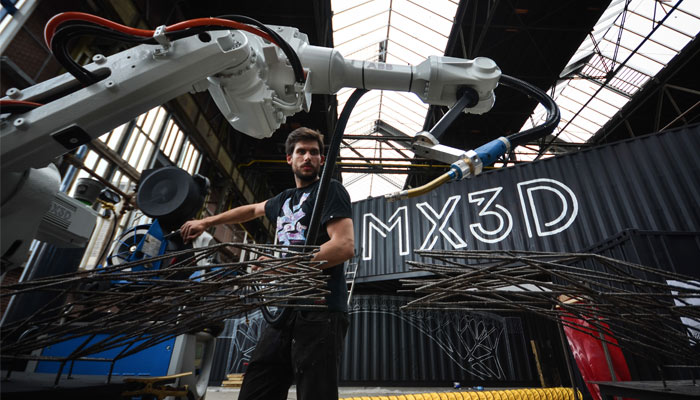
MX3D are one of a number of innovative startups in the 3D printed house sector.
Though conceptualised by startups, these projects frequently require support past bigger names in structure. The Royal BAM Group partnered with Eindhoven University of Technology to blueprint a 3D printed concrete bridge for cyclists. In addition, Bouygues Construction turned to 3D printing to build houses in the Lille, France. Moreover, Vinci Construction partnered with French startup XtreeE to exam the construction of complex structures, and Swedish group Skanska recently collaborated with the Academy of Loughborough to develop a 3D concrete printing process.
"we combined an industrial robot with a welding machine to turn it into a 3D printer that works with our own software," – MX3D team.
Why use 3D printing in structure?
Firstly, 3D printing physical saves a lot of fourth dimension. In detail, using these technologies potentially reduces a 2 week job to just 3-4 days. Moreover, this reduces risks of injury at work. Benoit Furet at the University of Nantes explains"the reduction of the hardship and the risks is a reality, we realized rays of 3.8m of height without any scaffolding. In addition, the structure site is very tranquillity."
His squad managed to print in 3D a 95m² house, and the outset 3D printed social housing in the metropolis. Benoit says their BatiPrint technology has besides fabricated it easier to create curved shapes at a lower cost. Moreover, equally 3D printers don't need to eat or sleep, they don't finish working until the projection is finished. This greatly reduces waiting times.
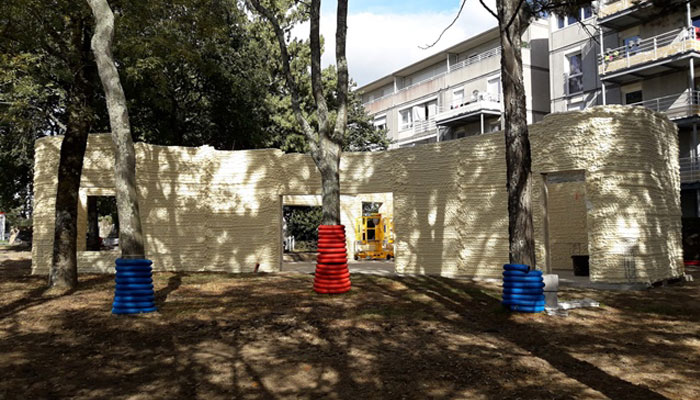
Advantages of 3D press in construction
In terms of materials usage, 3D press is economical. With additive rather than subtractive processes, less materials are used than traditional manufacturing processes. This reduces the environmental impact as less waste is produced.Romain Duballet, one of the co-founders of XtreeE, explains "with an increased geometric mastery, we can build optimized shapes to limit the corporeality of materials used."
However, there are withal caveats to the dream of 3D printing houses, bridges and skyscrapers. Axel Thèry of Constructions-3D explains that"the main difficulties come up from the fact that the process of 3D printing buildings is non today recognized as a construction method by many codes and standards bodies. As the printed structures are not traditional, the calculations of resistance and resistance in fourth dimension are difficult to realize, that is why the habitable works will accept to exist tested on a case by case ground at the beginning." These standards bodies are concerned whether these structures are really solid and if they can withstand their environments.
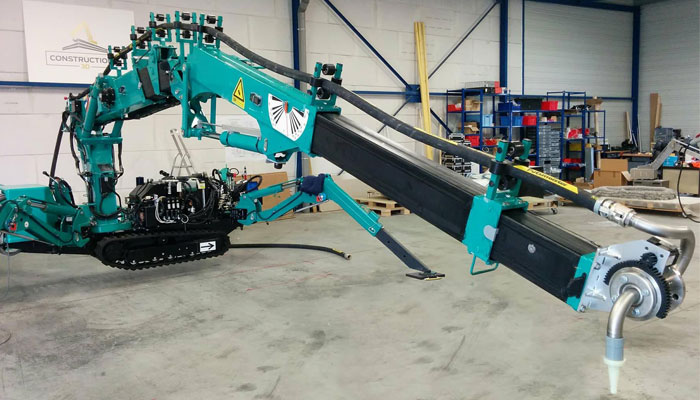
Constructions-3D'south car resembles a huge tractor, and 3D prints concrete to brand large structures.
3D printed firm: a solution to the housing crisis?
Since 3D printing now allows structures to be created more quickly, it is ideal to gainsay the housing crisis. Some companies are gravitating towards condiment manufacturing equally a outcome. This includes Italian visitor WASP, which aims to build a more sustainable globe through 3D press. They take developed one of the globe'southward largest 3D printers which is capable of building homes from locally sourced materials using solar, wind, or hydro power. This enables regions that don't yet accept access to electricity to 3D print environmentally friendly structures with local resource.
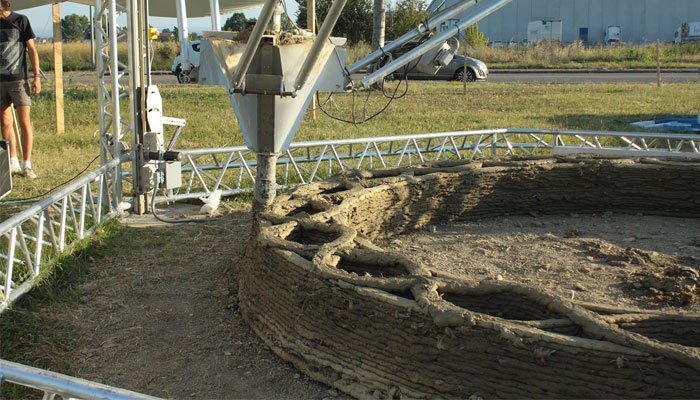
WASP 3D printers at work to create a future where environmentally friendly materials create 3D printed houses.
Similarly in Brazil, Anielle Guedes founded Urban3D to reply to Brazil's housing crisis. Her company 3D prints parts of buildings in a defended factory before assembling them on-site. This enables her to create buildings of a height that is not possible if 3D printing was done on-site. The visitor is currently testing several prototypes and hopes to provide a solution to the development of Brazilian shantytowns.
Russian visitor Apis Cor is besides convinced of the positive impact that 3D printing can have on housing. Founder and CEO NikitaChen-iun-tai explains, "we believe that additive manufacturing is an effective solution confronting the housing crunch and that is why we take developed our project. We hope that in a few years this arroyo will be thoroughly tested in different parts of the world to demonstrate its feasibility. We believe that more than and more construction companies will adopt this technology, equally it is already the case for some today."
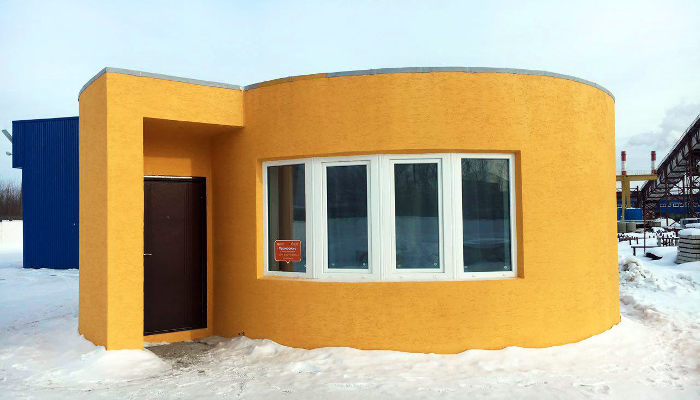
Russian company Apis Cor built this firm in but 24 hours using their concrete 3D printer.
3D Press in Infinite?
Additive manufacturing could besides be a way for humanity to explore space. NASA has launched the '3D Printed Habitat Challenge' examining technologies used to build homes in infinite, such as on the Moon or on Mars. Although ambitious, it is too early to tell if 3D printing is a viable solution. We can tell notwithstanding, that 3D printing in structure is to become a very existent global strength. SmarTech Publishing recently published a report predicting global revenues in the sector to be $40bn in 2027. To go from a few million dollars to $40bn in 10 years is amazing. Therefore, nosotros volition have to see how the world reacts to this tech in the futurity.
Did yous relish our feature story on 3D press in construction? Permit us know in a comment below or on our Facebook and Twitter pages! Sign upward for our free weekly Newsletter, all the latest news in 3D printing directly to your inbox!
jamisonwouturairim.blogspot.com
Source: https://www.3dnatives.com/en/3d-printing-construction-310120184/
0 Response to "construction union technology shift drawings 2d 3d"
Post a Comment